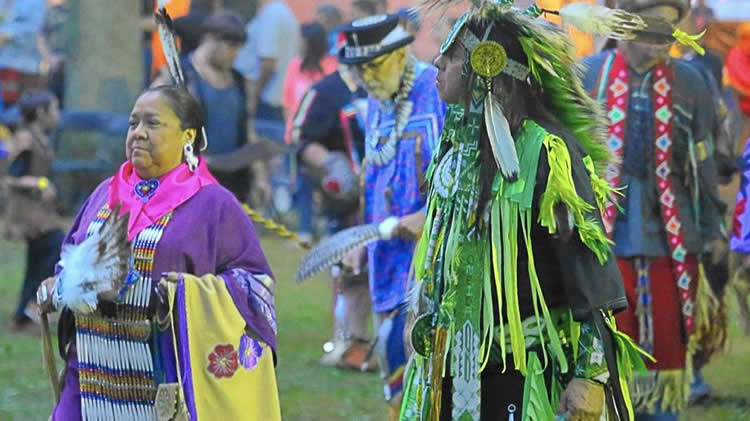
Pow-Wow Celebrates Northern Lake County's Native American Roots
Reprinted from the Lake County News-Sun (8-31-2015) - Click here for original article
By Denys Bucksten

Powerful, hypnotic, driving drumbeats served as continual backdrop to a weekend of dancing, good food, colorful dress and artifact displays at Potawatomi Trails 22nd Annual Pow-Wow in Zion.
The two-day event was held in a clearing in a heavily-wooded section of Shiloh Park, near the Lake Michigan shore settled by the Potawatomi some 400 years earlier.
Many of the estimated 3,000 visitors to the Pow-Wow — from northern Lake County and southern Wisconsin — claim Native American heritage.
Samara Castro, 14, dressed in a striking Indian shawl, performed a butterfly dance in the circular arena. Born and raised in Waukegan, Samara said she's part Cherokee and cherishes that link to the history of the continent.
Jamie Navarro of Kenosha brought his children, Alex, 12; and Marissa, 10, to the Pow-Wow to connect with their Chippewa roots, and eat some Indian tacos and buffalo burgers. Myella Rivera and her younger sister, Lilly, of Waukegan, browsed the crafts area looking for keepsakes. Stacy Aber, of Racine, a descendant of the Oneida tribe, claimed an Indian doll raffle prize.
Event organizer Bill Brown said the history of the Great Lakes Native Americans, Zion in particular, is not lost on those with Native American roots.
"Right here," he said, gesturing to the dense trees and nearby open space of the park, "this is an old council area, a gathering area, before the Dowie days (Christian Catholic Church started in 1896 in Zion by Scottish immigrant John Dowie).
"The Potawatomi would gather here, at the lakefront, between Waukegan and Kenosha. They chipped flint (from quarries for spears, scrapers, tools and arrowheads), and made birch-bark canoes because of all the birch bark trees here. They made pottery in ovens."
With events held regularly on weekends throughout the upper Midwest, Native Americans are also out to erase stereotypes, said Brown.
"The whole idea of Pow-Wow is to show people that as diverse as we are (as Americans), we are still a lot alike," Brown said. "I've had people ask me, 'When are you going to dance around the fire?' I tell them, 'You watch too much TV.'
"This is a way to learn who we really are and to come out and enjoy this with us."
Julie Hill has been attending Native American events "since childhood, at least 45 years," she said. "It's an expression of my culture (Oneida, Comanche and Kiowa), but my primary reason is my desire to dance.
"When I first started to dance I was praying to the creator, the one who has created this earth for us all. I prayed not for myself, but for my family, for those who were ill, people struggling with addictions, who would like to be in the circle (inner arena at events), but were not able to, either because of illness or those who have passed on.
"And I dance for the children who are coming up," she added.
Diane Porter owner of a family business, Bear Tracks, had a booth selling Native American crafts made from leather, cloth and feathers.
"We do this for our culture," she said.
As a 501c3, Potawatomi Trails Pow-Wow, Inc, depends on donations for funding. For more information, visit www.goflo.com/powwow.
Denys Bucksten is a New-Sun freelancer